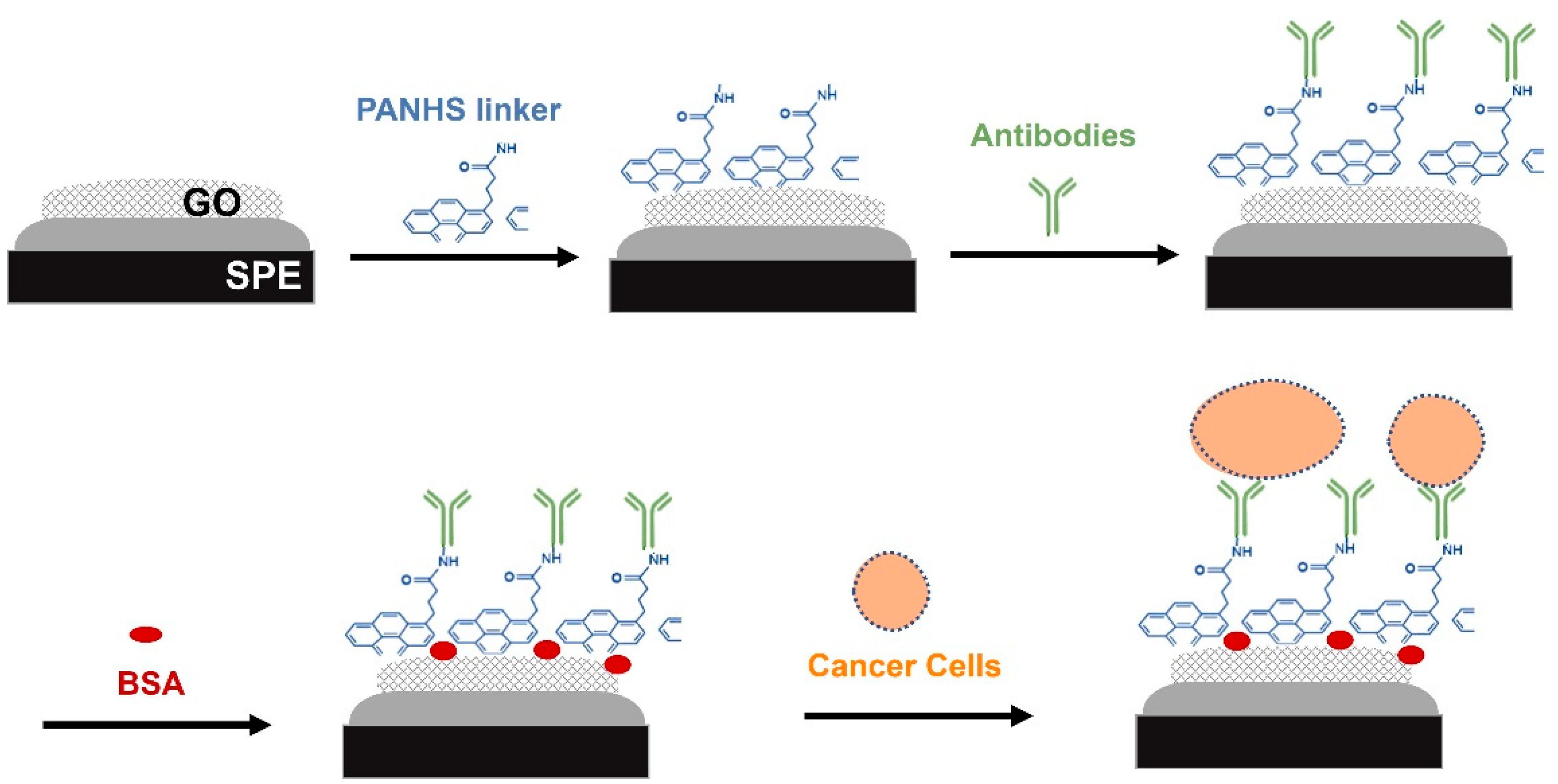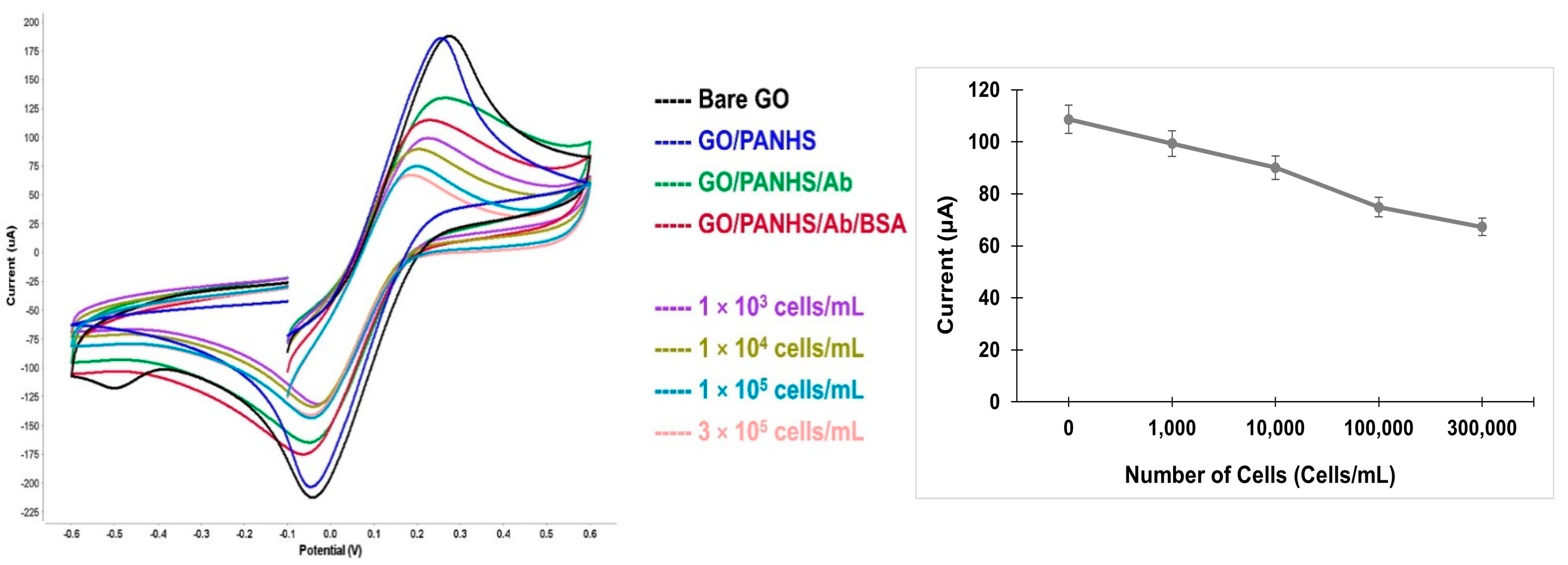Functionalization of Graphene Oxide for Label-Free Electrochemical Detection of Hepatic Cancer Cells †
Abstract
:1. Introduction
2. Materials and Methods
2.1. Fabrication of the Sensing Platform
2.2. Electrochemical Measurements
2.3. Cell Lines and Cell Culture
3. Results and Discussion
4. Conclusions
Author Contributions
Funding
Institutional Review Board Statement
Informed Consent Statement
Data Availability Statement
Conflicts of Interest
References
- Damiati, S.; Schuster, B. Electrochemical biosensors based on S-layer proteins. Sensors 2020, 20, 1721. [Google Scholar] [CrossRef] [PubMed]
- Brownson, D.; Banks, C. Interpreting Electrochemistry. In The Handbook of Graphene Electrochemistry; Springer: Berlin/Heidelberg, Germany, 2014; pp. 23–77. [Google Scholar]
- Damiati, S.; Peacock, M.; Mhana, R.; Søpstad, S.; Sleytr, U.B.; Schuster, B. Bioinspired Detection Sensor Based on Functional Nanostructures of S-Proteins to Target the Folate Receptors in Breast Cancer Cells. Sens. Actuators B 2018, 267, 224–230. [Google Scholar] [CrossRef]
- Bungon, T.; Haslam, C.; Damiati, S.; O’Driscoll, B.; Whitley, T.; Davey, P.; Siligardi, G.; Charmet, J.; Awan, S.A. Graphene FET sensors for Alzheimer’s disease protein biomarker Clusterin detection. Front. Mol. Biosci. 2021, 8, 651232. [Google Scholar] [CrossRef] [PubMed]
- Schuster, B. S-Layer Protein-Based Biosensors. Biosensors 2018, 8, 40. [Google Scholar] [CrossRef] [PubMed]
- Cooper, D.R.; D’Anjou, B.; Ghattamaneni, N.; Harack, B.; Hilke, M.; Horth, A.; Majlis, N.; Massicotte, M.; Vandsburger, L.; Whiteway, E. Experimental review of graphene. Int. Scholarly Res. Notices 2012, 2012, 501686. [Google Scholar] [CrossRef]
- Damiati, S.; Haslam, C.; Sopstad, S.; Peacock, M.; Whitley, T.; Davey, P.; Awan, S.A. Sensitivity comparison of macro- and micro-electrochemical biosensors for human chorionic gonadotropin (hCG) biomarker detection. IEEE Access 2019, 7, 94048–94058. [Google Scholar] [CrossRef]
- Geim, A.K.; Novoselov, K.S. The rise of graphene. Nat. Mater. 2007, 6, 183–191. [Google Scholar] [CrossRef] [PubMed]
- Haslam, C.; Damiati, S.; Whitley, T.; Davey, P.; Ifeachor, E.; Awan, S.A. Label-free sensors based on graphene field-effect transistors for the detection of human chorionic gonadotropin cancer risk biomarker. Diagnostics 2018, 8, 5. [Google Scholar] [CrossRef]


Disclaimer/Publisher’s Note: The statements, opinions and data contained in all publications are solely those of the individual author(s) and contributor(s) and not of MDPI and/or the editor(s). MDPI and/or the editor(s) disclaim responsibility for any injury to people or property resulting from any ideas, methods, instructions or products referred to in the content. |
© 2023 by the authors. Licensee MDPI, Basel, Switzerland. This article is an open access article distributed under the terms and conditions of the Creative Commons Attribution (CC BY) license (https://creativecommons.org/licenses/by/4.0/).
Share and Cite
Damiati, S.; Awan, S.A.; Peacock, M.; Schuster, B. Functionalization of Graphene Oxide for Label-Free Electrochemical Detection of Hepatic Cancer Cells. Eng. Proc. 2023, 35, 13. https://doi.org/10.3390/IECB2023-14599
Damiati S, Awan SA, Peacock M, Schuster B. Functionalization of Graphene Oxide for Label-Free Electrochemical Detection of Hepatic Cancer Cells. Engineering Proceedings. 2023; 35(1):13. https://doi.org/10.3390/IECB2023-14599
Chicago/Turabian StyleDamiati, Samar, Shakil A. Awan, Martin Peacock, and Bernhard Schuster. 2023. "Functionalization of Graphene Oxide for Label-Free Electrochemical Detection of Hepatic Cancer Cells" Engineering Proceedings 35, no. 1: 13. https://doi.org/10.3390/IECB2023-14599
APA StyleDamiati, S., Awan, S. A., Peacock, M., & Schuster, B. (2023). Functionalization of Graphene Oxide for Label-Free Electrochemical Detection of Hepatic Cancer Cells. Engineering Proceedings, 35(1), 13. https://doi.org/10.3390/IECB2023-14599







